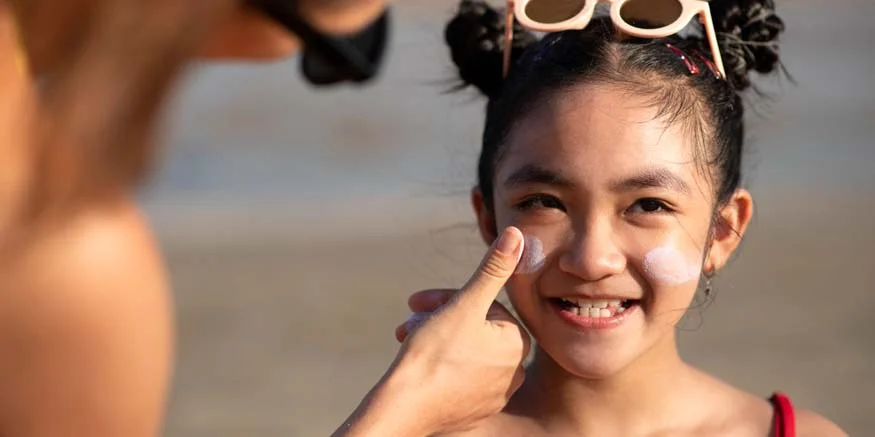Protecting your little one’s skin from the damaging effects of the sun is crucial for parents. Sunscreens play a vital role in safeguarding your baby’s delicate skin from ultraviolet (UV) radiation.
Hence, it is essential to understand how to choose the right sunscreen and apply it properly to ensure your child’s skin is protected. Here are key sunscreen tips every parent should remember to shield their kids from the sun’s potential harm.
Read more: Personal Grooming Tips for Kids: Importance & Benefits
Importance of Protecting Young Skin from the Sun
Babies and toddlers have delicate skin and less defense against the sun, making them prone to skin damage. Childhood sunburns can double the risk of serious skin cancer later in life. Hence, being careful about sun protection significantly lowers this risk.
Selecting the Right Sunscreen
Choose sunscreens formulated for babies and toddlers. Here is a guide to picking the right one for them:
- Broad Spectrum Protection
- Appropriate SPF
- Physical over Chemical Sunscreens
- Water Resistance
- Fragrance-free and Hypoallergenic
When selecting sunscreen for your child, seek products labelled “broad-spectrum.” This means the sunscreen shields against both UVA and UVB rays, which can harm the skin.
Select a sunscreen with an SPF of at least 30, which blocks approximately 97% of UVB rays. Higher numbers indicate additional protection, but no sunscreen can block 100% of UV rays.
Physical (mineral-based) sunscreens containing zinc oxide or titanium dioxide tend to be less irritating for sensitive skin. They work by sitting on top of the skin to physically block UV rays and start working immediately upon application. Chemical sunscreens, on the other hand, absorb UV radiation and may contain ingredients that could irritate young skin or cause allergic reactions.
Opt for water-resistant sunscreen if your child will be participating in water activities or sweating. Water-resistant formulas protect for either 40 or 80 minutes while the child is in the water, as indicated on the label.
Parents should consider fragrance-free and hypoallergenic options specifically formulated for sensitive skin to minimize allergy risks.
When to Start Using Sunscreen
- For newborns and infants:
- For toddlers:
Paediatricians advise against using sunscreen due to concerns about chemical absorption in this age group. Instead, keep them out of the sun and dress them in long-sleeved clothes and hats for protection. Use stroller covers and shade structures to shield infants from UV rays. If you cannot cover them well, apply a bit of sunscreen (at least 15 SPF) to small areas like the face and back of the hands.
Parents can start applying sunscreen especially formulated for children with a sun protection factor (SPF) of at least 30. This protects against both UVA and UVB rays.
Ensure that all exposed skin is adequately covered with sunscreen. Make sure to use protective clothing, hats, and UV-blocking sunglasses in addition to sunscreen. Remember to shield areas like the ears, neck, and backs of knees and hands. Health experts suggest avoiding strong sunlight between 10 a.m. and 4 p.m.
Application Tips
Before heading outside, apply sunscreen generously to all exposed areas of your child’s skin, including the face (avoiding the eyes and mouth), ears, hands, and feet. Use an ounce (like a shot glass) of lotion to cover the whole body. Put sunscreen on 15 to 30 minutes before going outside and reapply every two hours. If your child swims or sweats a lot, put on more sunscreen often.
Sunscreen and Water Activities
If your child is spending time in the water, it is essential to use a water-resistant sunscreen. Even water-resistant sunscreens should be reapplied every 40 to 80 minutes as their effectiveness wears off with swimming and towel drying.
Sensitivity and Allergies
Sensitivity and allergies to sunscreen can pose significant concerns for parents of toddlers and infants. The delicate skin of young children is particularly susceptible to reactions from chemical ingredients found in many sunscreens. There are chemical sunscreens, which absorb ultraviolet (UV) radiation through a chemical reaction that can irritate.
Sunscreen allergies in toddlers and infants cause redness, itching, and sometimes blistering of the skin. To minimise risks, parents and caregivers should conduct a patch test by applying a small amount of sunscreen to the inside of the infant’s wrist and observing for any adverse reactions over 24 hours. Any reaction should prompt discontinuation of the product and consultation with a paediatrician or dermatologist.
Age-Appropriate Products
Sunscreen sticks are often convenient for applying to a baby or toddler’s face, while sprays can be more challenging to use accurately and safely around young children. If you use spray sunscreen, apply it first to your hands and then rub it onto your child’s skin to avoid inhalation.
Check on Expiration Dates
Like any other skincare product, sunscreen has an expiration date. Using expired sunscreen can reduce its effectiveness, and the texture or fragrance of the product may change. Check the packaging for expiration dates and replace products as needed.
Daily Use
Sunscreen should not only be for the beach or pool days; incorporating it into your child’s daily routine can provide consistent protection, especially on areas that are often exposed to the sun, such as the face and hands.
Combine the use of sunscreen with other protective measures. Dress toddlers and infants in lightweight clothing that covers the arms and legs, and use wide-brimmed hats to shield their face and neck. UV-blocking sunglasses can also help protect their sensitive eyes.
These tips help protect your baby, toddler, or infant from the sun. Hence, it is essential to incorporate sun safety practices early to instil healthy habits that children can carry throughout their lives.
For more such informative blogs, Visit EuroSchool!









